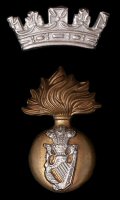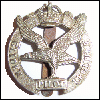 |
 L: Royal Irish Fusiliers top: Glider Pilot Regiment |
 |
 L: Royal Irish Fusiliers top: Glider Pilot Regiment |
Cecil Bourke Connell (b. India 1887, son of John Bourke Connell) married at Bangladore, Madras, 12/7/1918, Caroline Alice Lowry (b. 1897, daughter of Charles John Lowry). Michael, reportedly their only son was also born in India, circa 1919.
In 1906 Cecil was at the Royal Indian Engineering College at Cooper's Hill, Surrey. He was employed by the Public Works Department, India, 1907-1929, and in WWI had been appointed Temp. 2nd Lt. in 38th East Coast Battalion, Indian Defence Force. He rose to the rank of Senior Executive Engineer, Madras. On 24 December 1929 he became an Engineering Inspector in the Ministry of Health, England. He was a Member of the Institution of Civil Engineers.
In 1930 he had come to live at St Erth, Oakfield Road, so his son Michael's early childhood would have been elswhere. By 1938 the family residence was at Moorlands, The Marld, Ashtead. Cecil B Connell died aged 55, at Horton Emergency Hospital, Epsom on 14th May 1941. His widow Caroline was granted probate (£4375) and later moved to Felcourt, West Farm Close in Ashtead. Her death at the age of 90 was registered in Bath, Somerset in 1986. Both Michael's parents are buried at St Giles' churchyard, Ashtead. http://www.gravestonephotos.com/public/gravedetails.php?grave=45345&scrwidth=1200
Michael Bourke Connell was educated at Haileybury and is on their Roll of Honour.
WACO glider of the type used in training for operations in Sicily
http://www.pegasusarchive.org/sicily/frames.htm
The book Glider Pilots in Sicily by Mike Peters (Casemate Publishers, 2013) has some references to him, summarised as follows:
Lt Michael Connell was in 3 Squadron 1st Battalion Glider Pilot Regiment. Originally commissioned into the Royal Irish Fusiliers, he was in France during the 'Phoney War' but also gained experience during the chaotic final stages of the German Blitzkrieg campaign. He was eventually evacuated to England from Dunkirk in June 1940.
He volunteered for training as a glider pilot. After gaining his wings he was posted to 1st Battalion Glider Pilot Regiment and to North Africa. The gliders he was to operate with were the American WACO type, called Hadrian when used in the British forces.
A letter to his mother on 9th June 1943 includes advice on using Airgraph letters and says that the hot weather means he spends the greater part of the day absolutely dripping - they don't work between noon and 3pm but start at 5.30am.
A week later 1 Bn GPR's War Diary recorded that Flying Training of 116 crews was completed to operational standard, with the basic WACO conversion syllabus complete, though not without injuries and deaths.
'Vin Blanc' was a dry run training exercise using 3 ton trucks instead of gliders to test the mounting and landing procedures with glider pilots accompanying their respective infantry 'chalks' [the chalk number was the way in which the glider load (troops/equipment) knew which glider was to carry them. It is believed that it originated in the number chalked on the glider].
The glider pilots also practised their roles in the operation immediately after landing. The intensive training not only began to tell on those taking part but also on the WACO gliders. The haste with which some of the aircraft had been assembled by inexperienced fitters, together with a lack of proper maintenance was resulting in a dramatic increase in mechanical failures. The Americans accordingly grounded most of the WACOs available for training to allow matters to be put right.
A few days after 'Vin Blanc' Michael wrote home again. He was now under canvas. It was dusty. Fruit was beginning to be available. He had been photographed by the Press "so look out in the papers a few days back it is a movie shot and shows me shepherding chaps into a glider."
The Times August 7, 1943
Missing in July 1943, during the invasion of Sicily, Lt. Michael Bourke Connell, The Royal Irish Fusiliers (attached The Glider Pilot Rgt.) dear only son of Carol Connell of Moorlands, Ashtead, Surrey (now at Felcourt, West Farm Close, Ashtead) and the late Cecil Bourke Connell, aged 24.
He died on 10/07/1943, on OPERATION LADBROKE. A presumption is that he was among those lost when their gliders crashed into the sea, as he has no known grave and is accordingly commemorated on the CASSINO MEMORIAL, Panel 11. The National Probate calendar entry for him states that he died at sea.
His CWGC record is at http://www.cwgc.org/search/casualty_details.aspx?casualty=2069561
In summary, according to the Wikipedia page on OPERATION LADBROKE, this was a glider landing of British airborne forces near Syracuse, Sicily, that began on 9 July 1943 as part of the Allied invasion of the island, OPERATION HUSKY. This first Allied mission using large numbers of gliders was carried out from Tunisia by the 1st Airlanding Brigade, with a force of 136 Wacos and eight Horsas. The objective was to establish a large invasion force on the ground near the town of Syracuse, secure the Ponte Grande Bridge and ultimately take control of the city itself with its strategically vital docks, as a prelude to the full-scale invasion of Sicily.
Colonel George Chatterton, the commander of the Glider Pilot Regiment (GPR), had protested about their participation as he believed they were entirely unfit for any operation. The GPR had been flying Horsa gliders and did not operate at night. When the training period for the brigade ended with a total of two exercises completed, the glider pilots had an average of 4.5 hours training in flying the unfamiliar Waco, which included an average of 1.2 hours night flying.
En route to Sicily, sixty-five gliders released too early by the American and British towing aircraft crashed into the sea, drowning approximately 252 men. Of the remainder, only eighty-seven men arrived at the Pont Grande Bridge, although they successfully captured the bridge and held it beyond the time they were to be relieved. Finally, with their ammunition expended and only fifteen soldiers remaining unwounded, the Allied troops surrendered to Italian forces. The Italians, having gained control of the bridge, sought to destroy the structure, but were frustrated by soldiers of 1st Brigade who had removed the previously attached explosive charges. Other troops from the airlanding brigade, who had landed elsewhere in Sicily aided further by destroying communications links and capturing gun batteries.
After an enquiry into the problems with the airborne missions in Sicily, the British Army and RAF submitted recommendations in the aftermath of OPERATION LADBROKE:
page added: 5 Feb 2009: If you can add to this page please contact
the editor
page last updated 6 May 15: with thanks to Ann Williams and Brian
Bouchard